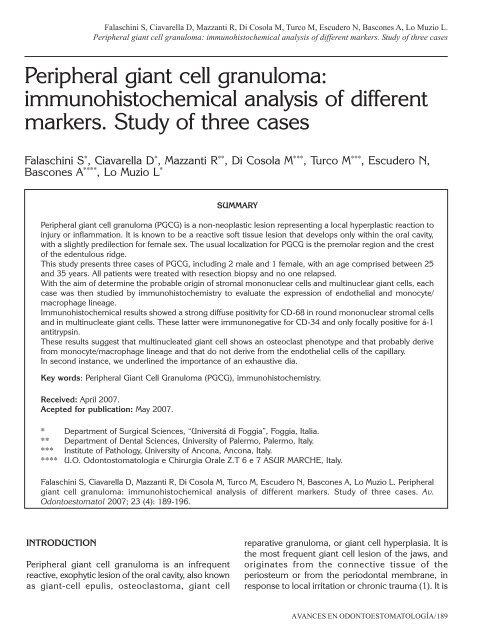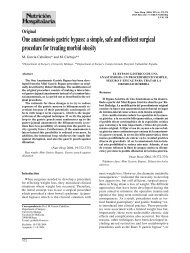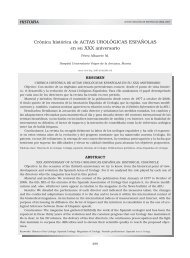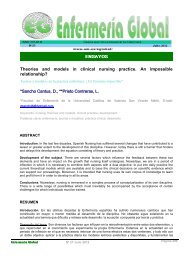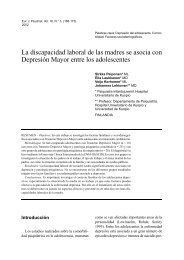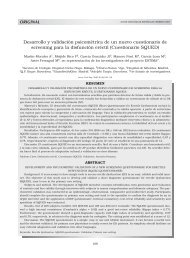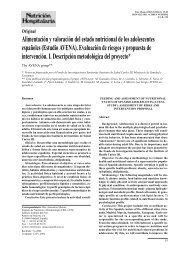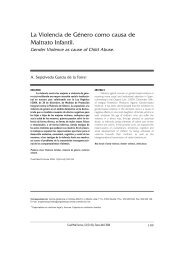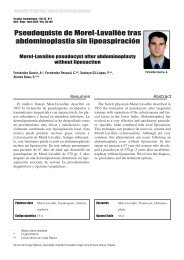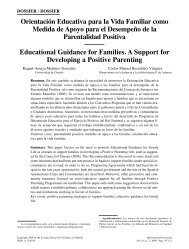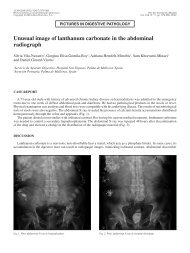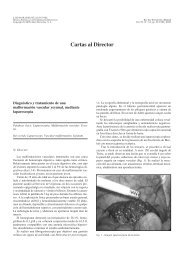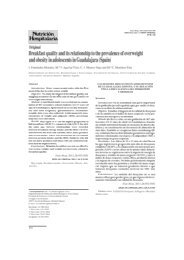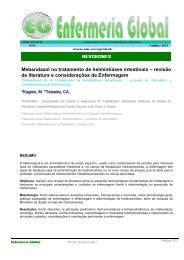Peripheral giant cell granuloma: immunohistochemical analysis of ...
Peripheral giant cell granuloma: immunohistochemical analysis of ...
Peripheral giant cell granuloma: immunohistochemical analysis of ...
Create successful ePaper yourself
Turn your PDF publications into a flip-book with our unique Google optimized e-Paper software.
Falaschini S, Ciavarella D, Mazzanti R, Di Cosola M, Turco M, Escudero N, Bascones A, Lo Muzio L.<br />
<strong>Peripheral</strong> <strong>giant</strong> <strong>cell</strong> <strong>granuloma</strong>: <strong>immunohistochemical</strong> <strong>analysis</strong> <strong>of</strong> different markers. Study <strong>of</strong> three cases<br />
<strong>Peripheral</strong> <strong>giant</strong> <strong>cell</strong> <strong>granuloma</strong>:<br />
<strong>immunohistochemical</strong> <strong>analysis</strong> <strong>of</strong> different<br />
markers. Study <strong>of</strong> three cases<br />
Falaschini S * , Ciavarella D * , Mazzanti R ** , Di Cosola M *** , Turco M *** , Escudero N,<br />
Bascones A **** , Lo Muzio L *<br />
SUMMARY<br />
<strong>Peripheral</strong> <strong>giant</strong> <strong>cell</strong> <strong>granuloma</strong> (PGCG) is a non-neoplastic lesion representing a local hyperplastic reaction to<br />
injury or inflammation. It is known to be a reactive s<strong>of</strong>t tissue lesion that develops only within the oral cavity,<br />
with a slightly predilection for female sex. The usual localization for PGCG is the premolar region and the crest<br />
<strong>of</strong> the edentulous ridge.<br />
This study presents three cases <strong>of</strong> PGCG, including 2 male and 1 female, with an age comprised between 25<br />
and 35 years. All patients were treated with resection biopsy and no one relapsed.<br />
With the aim <strong>of</strong> determine the probable origin <strong>of</strong> stromal mononuclear <strong>cell</strong>s and multinuclear <strong>giant</strong> <strong>cell</strong>s, each<br />
case was then studied by immunohistochemistry to evaluate the expression <strong>of</strong> endothelial and monocyte/<br />
macrophage lineage.<br />
Immunohistochemical results showed a strong diffuse positivity for CD-68 in round mononuclear stromal <strong>cell</strong>s<br />
and in multinucleate <strong>giant</strong> <strong>cell</strong>s. These latter were immunonegative for CD-34 and only focally positive for á-1<br />
antitrypsin.<br />
These results suggest that multinucleated <strong>giant</strong> <strong>cell</strong> shows an osteoclast phenotype and that probably derive<br />
from monocyte/macrophage lineage and that do not derive from the endothelial <strong>cell</strong>s <strong>of</strong> the capillary.<br />
In second instance, we underlined the importance <strong>of</strong> an exhaustive dia.<br />
Key words: <strong>Peripheral</strong> Giant Cell Granuloma (PGCG), immunohistochemistry.<br />
Received: April 2007.<br />
Acepted for publication: May 2007.<br />
* Department <strong>of</strong> Surgical Sciences, “Universitá di Foggia”, Foggia, Italia.<br />
** Department <strong>of</strong> Dental Sciences, University <strong>of</strong> Palermo, Palermo, Italy.<br />
*** Institute <strong>of</strong> Pathology, University <strong>of</strong> Ancona, Ancona, Italy.<br />
**** U.O. Odontostomatologia e Chirurgia Orale Z.T 6 e 7 ASUR MARCHE, Italy.<br />
Falaschini S, Ciavarella D, Mazzanti R, Di Cosola M, Turco M, Escudero N, Bascones A, Lo Muzio L. <strong>Peripheral</strong><br />
<strong>giant</strong> <strong>cell</strong> <strong>granuloma</strong>: <strong>immunohistochemical</strong> <strong>analysis</strong> <strong>of</strong> different markers. Study <strong>of</strong> three cases. Av.<br />
Odontoestomatol 2007; 23 (4): 189-196.<br />
INTRODUCTION<br />
<strong>Peripheral</strong> <strong>giant</strong> <strong>cell</strong> <strong>granuloma</strong> is an infrequent<br />
reactive, exophytic lesion <strong>of</strong> the oral cavity, also known<br />
as <strong>giant</strong>-<strong>cell</strong> epulis, osteoclastoma, <strong>giant</strong> <strong>cell</strong><br />
reparative <strong>granuloma</strong>, or <strong>giant</strong> <strong>cell</strong> hyperplasia. It is<br />
the most frequent <strong>giant</strong> <strong>cell</strong> lesion <strong>of</strong> the jaws, and<br />
originates from the connective tissue <strong>of</strong> the<br />
periosteum or from the periodontal membrane, in<br />
response to local irritation or chronic trauma (1). It is<br />
AVANCES EN ODONTOESTOMATOLOGÍA/189
AVANCES EN ODONTOESTOMATOLOGÍA<br />
Vol. 23 - Núm. 4 - 2007<br />
more frequent in women than in men, with a slightly<br />
higher prevalence in the 30- to 70-year-old-age group,<br />
and affects largely the lower jaw (55%) than in the<br />
upper jaw (the reported proportion being 2,4:1) (2).<br />
Cases <strong>of</strong> PGCG have been documented in children,<br />
where the lesion appears to be more aggressive, with<br />
absorption <strong>of</strong> the interproximal crest area,<br />
displacement <strong>of</strong> the adjacent teeth and multiple<br />
recurrences (3).<br />
Clinically, it manifests as a s<strong>of</strong>t to firm, bright nodule<br />
or as a sessile or pediculate mass, which is<br />
predominantly bluish red with a smooth shiny or<br />
mamillated surface, localized in the gingival tissue or<br />
alveolar processes <strong>of</strong> the incisor and canine region<br />
(1), through according to Pindborg the preferential<br />
location is the premolar and molar zone (4). The<br />
lesion ranges in size from small papules to enlarged<br />
masses, though reportedly rarely exceeding 2 cm in<br />
diameter, and are generally located in the interdental<br />
papilla, edentulous alveolar margin, or at marginal<br />
gum level (5). It is basically asymptomatic, in fact<br />
pain is not a common characteristic, and lesion<br />
growth in most cases is induced by repeated trauma<br />
such as with occlusion, in which case it may ulcerate<br />
and becomes infected (6, 7).<br />
Although the pathogenesis <strong>of</strong> oral cavity PGCGs is<br />
still uncertain, local irritants such as calculus, bacterial<br />
plaque, periodontitis, periodontal surgery, ill-fitting<br />
dentures, overhanging restorations and tooth<br />
extractions are suggested as the etiological causes<br />
(8-10). These are s<strong>of</strong>t tissue lesions that rarely affect<br />
the underlying bone, though the latter may suffer<br />
erosion (5, 11). Treatment comprises surgical<br />
resection, with extensive clearing <strong>of</strong> the base <strong>of</strong> the<br />
lesion to avoid relapses (12).<br />
The present study describes three clinical cases <strong>of</strong><br />
peripheral <strong>giant</strong> <strong>cell</strong> <strong>granuloma</strong> located in different<br />
areas. We analyzed the presence and tissue<br />
localization <strong>of</strong> several markers such as CD68, CD34<br />
and α1- antitrypsin by immunohistochemistry, for the<br />
purpose <strong>of</strong> evaluating the origin <strong>of</strong> stromal mononuclear<br />
<strong>cell</strong>s and multinucleate <strong>giant</strong> <strong>cell</strong>s. Finally we<br />
underlined the importance <strong>of</strong> a early clinic,<br />
radiographic and histologic diagnosis to prevent<br />
possible damages to the teeth and adjacent bone<br />
190/AVANCES<br />
EN ODONTOESTOMATOLOGÍA<br />
CLINICAL CASES<br />
Case 1<br />
A 27-years-old Bolivian woman without disease<br />
antecedents <strong>of</strong> interest or known drug allergies<br />
referred for resection-biopsy <strong>of</strong> a gingival epulis. The<br />
lesion was located between the second and third<br />
molar, measured 1.8×1.5 cm in size, was purple in<br />
colour and bleeding if touched (fig. 1a). The periapical<br />
X-rays showed a bone loss between 1.7 and 1.8,<br />
demonstrating the possible involvement <strong>of</strong> the periodontal<br />
ligament (fig. 1b).<br />
Treatment consists <strong>of</strong> lesion resection under<br />
infiltrating anaesthesia, followed by the total avulsion<br />
<strong>of</strong> 17 and 18. The histological study confirmed the<br />
diagnosis <strong>of</strong> peripheral <strong>giant</strong> <strong>cell</strong> <strong>granuloma</strong>,<br />
described as ulcerated fibrous epulis with moderate<br />
chronic lymphoplasma<strong>cell</strong>ular inflammatory infiltrate.<br />
Control examination after six days showed the complete<br />
restitution ad integrum <strong>of</strong> the tissue; six months<br />
after resection there were not signs <strong>of</strong> relapse.<br />
Case 2<br />
A 25-years-old Italian male referred for removal <strong>of</strong> a<br />
tooth, 15, because it is very damaged and difficult to<br />
Fig. 1a. Case 1: The peripheral <strong>giant</strong> <strong>cell</strong> <strong>granuloma</strong> localized<br />
between second premolar and third top molar.
Falaschini S, Ciavarella D, Mazzanti R, Di Cosola M, Turco M, Escudero N, Bascones A, Lo Muzio L.<br />
<strong>Peripheral</strong> <strong>giant</strong> <strong>cell</strong> <strong>granuloma</strong>: <strong>immunohistochemical</strong> <strong>analysis</strong> <strong>of</strong> different markers. Study <strong>of</strong> three cases<br />
Fig. 1b. Case 1. Periapical radiography.<br />
restore. Intraoral examination revealed also the<br />
presence <strong>of</strong> bad oral hygiene with several amounts<br />
<strong>of</strong> plaque on the surface <strong>of</strong> all teeth, and the absence<br />
<strong>of</strong> 27, 34 and 46. The 15 avulsion was performed<br />
under infiltrating local anaesthesia. There were no<br />
complications in the immediate postoperative period,<br />
but after a week, when the patient returned to the<br />
dentist to removal the suture, he showed an exophytic<br />
lesion in the treated region. It had a pedunculate<br />
base, s<strong>of</strong>t consistency and purple in colour,<br />
measuring 1.5×2 cm in size (fig. 1c). Resection<br />
Fig. 1c. Case 2. The peripheral <strong>giant</strong> <strong>cell</strong> <strong>granuloma</strong> in the extraction<br />
place.<br />
biopsy was performed, and the histological study<br />
showed the presence <strong>of</strong> peripheral <strong>giant</strong> <strong>cell</strong> <strong>granuloma</strong>.<br />
Case 3<br />
A 35-years-old Italian male with a history <strong>of</strong> cardiac<br />
infarction referred with an exophytic lesion located<br />
between 42 and 43. Clinical exploration revealed a<br />
s<strong>of</strong>t large-base purple coloured lesion, measuring<br />
1.5×2 cm in size (fig. 1d). The patient referred only<br />
slight discomfort during mastication and bleeding<br />
with the brushing. Tooth 43 was vital, there was no<br />
painful to percussion and no mobility to palpation<br />
and the oral hygiene was very deficient. The X-rays<br />
study did not show bone disruption and radicular<br />
reabsorption <strong>of</strong> 43. The lesion was treated by surgery<br />
using infiltrating local anaesthesia, with a curettage<br />
<strong>of</strong> the radicular surface after the resection. The<br />
histological diagnosis was peripheral <strong>giant</strong> <strong>cell</strong> <strong>granuloma</strong>.<br />
Each case was then studied by immunohistochemistry<br />
to evaluate some inflammatory, endothelial<br />
and stromal markers.<br />
Fig. 1d. Case 3. The peripheral <strong>giant</strong> <strong>cell</strong> <strong>granuloma</strong> localized<br />
between 42 and 43.<br />
AVANCES EN ODONTOESTOMATOLOGÍA/191
AVANCES EN ODONTOESTOMATOLOGÍA<br />
Vol. 23 - Núm. 4 - 2007<br />
IMMUNOHISTOCHEMICAL ANALYSIS<br />
A formalin fixed, paraffin embedded block from a<br />
representative area <strong>of</strong> the lesion was selected. Serial<br />
sections were cut at 4 micron and mounted. One slide<br />
<strong>of</strong> these was stained with hematoxylin and eosin, the<br />
others examined <strong>immunohistochemical</strong>ly by the avidinbiotin<br />
peroxidases complex method, using the following<br />
monoclonal primary antibodies: anti–CD68 (PG-M1,<br />
DAKO, Carpinteria, CA, USA) at diluition <strong>of</strong> 1:200,<br />
anti-CD34 (QBEND-10, DAKO, Carpinteria, CA, USA)<br />
at diluition <strong>of</strong> 1:500 and anti- α-1 antitrypsin (N1533,<br />
DAKO, Carpinteria, CA, USA) at diluition <strong>of</strong> 1:1000.<br />
Immunohistochemically, macrophages and <strong>giant</strong><br />
<strong>cell</strong>s share similar antigenic inflammatory markers,<br />
such as those studied by us (13-15).<br />
Immunohistochemistry is performed on the sections<br />
mounted on poly-l-lysine-coated glass slides.<br />
Deparaffinized and rehydrated sections are incubated<br />
for 30 minutes in 3% H 2 O 2 /methanol to quench<br />
endogenous peroxidase activity and then rinse for 20<br />
minutes with phosphate-buffered saline (PBS) (Bio-<br />
Optica M107, Milan, Italy). Nonspecific protein<br />
binding is attenuated by incubation for 30 minutes<br />
with 5% horse serum in PBS. Specimens are<br />
incubated overnight with the monoclonal mouse<br />
antihuman CD34, CD68 and α-1 antitripsina protein.<br />
The antibody is applied directly to the section and the<br />
slides are incubated overnight (48C) in a humidified<br />
chamber. The sections are washed 3 times with PBS<br />
at room temperature. Immune complexes are<br />
subsequently treated with the secondary biotinylated<br />
antibody and then detected by streptavidin peroxidase,<br />
both incubated for 30 minutes at room temperature<br />
(Vectastain ABC kit, Vector Laboratories, Burlingame,<br />
Calif ). After rinsing with 3 changes <strong>of</strong> PBS the<br />
immunoreactivity is visualized by development for 2<br />
minutes with 0.1% 3,3V-diaminobenzidine and 0.02%<br />
hydrogen peroxide (DAB substrate kit, Vector<br />
Laboratories). Sections are counterstained with Mayer’s<br />
haematoxylin, mounted with permanent mounting<br />
medium, and examined by light microscopy.<br />
In each simple we analysed the differents histological<br />
and Immunohistochemical characteristic <strong>of</strong> 25 random<br />
lands using a conventional microscope with high<br />
potency <strong>of</strong> magnification (magnification 400×) (the<br />
192/AVANCES<br />
EN ODONTOESTOMATOLOGÍA<br />
pathologist performed a semiquantative <strong>analysis</strong> <strong>of</strong> the<br />
sample and he didn’t use a s<strong>of</strong>tware <strong>of</strong> the image).<br />
The histological carachetristics <strong>of</strong> these lesions<br />
consisteded in an hyperplastic granulation tissue with<br />
many multinucleated <strong>giant</strong> <strong>cell</strong>s (Figs. 2a, b). These<br />
<strong>giant</strong> <strong>cell</strong> were localized in the deep corion in a vascular<br />
stroma <strong>of</strong> ovoid and spindle-shaped<br />
fibroblastys. There were also several areas<br />
characterised by haemorrhage, underlined by the<br />
presence <strong>of</strong> Fe deposits.<br />
Immunohistochemically, all lesions showed a<br />
consistent immunopositivity for CD68 in macro-<br />
Fig. 2a. Case 2.<br />
Fig. 2b. Case 2.
Falaschini S, Ciavarella D, Mazzanti R, Di Cosola M, Turco M, Escudero N, Bascones A, Lo Muzio L.<br />
<strong>Peripheral</strong> <strong>giant</strong> <strong>cell</strong> <strong>granuloma</strong>: <strong>immunohistochemical</strong> <strong>analysis</strong> <strong>of</strong> different markers. Study <strong>of</strong> three cases<br />
phages, monocyte and, in particular, in multinucleated<br />
<strong>giant</strong> <strong>cell</strong>s (fig. 3a). Interestingly, in the<br />
periphery <strong>of</strong> the lesion these ones showed a moderate<br />
positivity <strong>of</strong> the blood vessels to CD34 related antigen<br />
(fig. 3b), reaction not evident deeper in the lesion<br />
within the aggregations <strong>of</strong> <strong>giant</strong> <strong>cell</strong>s. The stromal<br />
<strong>cell</strong>s and histiocytes were also positive for α-1<br />
antitrypsin (fig. 3c).<br />
DISCUSSION<br />
<strong>Peripheral</strong> <strong>giant</strong> <strong>cell</strong> <strong>granuloma</strong> (PGCG) is a benign<br />
lesion characterized by a hyperplastic reaction to lo-<br />
Fig. 3a. Analysis <strong>immunohistochemical</strong> <strong>of</strong> CD-68 (×100).<br />
cal injury or chronic trauma, developing only within<br />
the oral cavity (Flaitz CM 2000). The usual localization<br />
for PGCG is the gingival tissue in premolar region<br />
and the crest <strong>of</strong> the edentulous ridge. It is never found<br />
on mucosa that is not attached to bone (8). It is<br />
most common than central <strong>giant</strong> <strong>cell</strong> <strong>granuloma</strong> with<br />
a ratio <strong>of</strong> approximately 3:1, in fact Junquera and<br />
co-workers (10) mentioned the rarity <strong>of</strong> CGCG (0.4%-<br />
1.9%) in light <strong>of</strong> the related literature.<br />
Histologically, PGCG presents as a not-well circumscribed<br />
mass, constituted by fibrillar collagenous<br />
stroma containing two types <strong>of</strong> mononuclear <strong>cell</strong>s<br />
(spindle and ovoid <strong>cell</strong>s) and interspersed numerous<br />
multinucleated <strong>giant</strong> <strong>cell</strong>s “osteoclasts-like” or larger<br />
than typical osteclasts, having rarely normal bone<br />
resorptive function. Sometimes these <strong>cell</strong>s are also<br />
localized in the internal wall <strong>of</strong> vessels.<br />
It is present a chronic and <strong>of</strong>ten acute inflammatory<br />
infiltrate and hemosiderin-laden macrophages surround<br />
areas <strong>of</strong> haemorrhage (16). It is characterized by rich<br />
vasculature, particularly in the peripheral areas,<br />
consisting mainly <strong>of</strong> thin walled, small sized vessels.<br />
It contains numerous multinuclear <strong>giant</strong> <strong>cell</strong>s, but<br />
when compared to <strong>giant</strong> <strong>cell</strong> tumour, it is more<br />
fibrous.<br />
Its pathogenesis is not been thoroughly investigated.<br />
Several <strong>immunohistochemical</strong> studies have focused<br />
Fig. 3b. Analysis <strong>immunohistochemical</strong> <strong>of</strong> CD-34 (×100). Fig. 3c. Analysis <strong>immunohistochemical</strong> <strong>of</strong> α-1 anti-tripsin (×250).<br />
AVANCES EN ODONTOESTOMATOLOGÍA/193
AVANCES EN ODONTOESTOMATOLOGÍA<br />
Vol. 23 - Núm. 4 - 2007<br />
on identifying the nature and the interrelations<br />
between <strong>cell</strong>ular components in the formation <strong>of</strong><br />
GCG: the results have suggested that the mononuclear<br />
stromal <strong>cell</strong>s may originate from fibroblasts and<br />
<strong>cell</strong>s <strong>of</strong> histiocytic origin whereas the origin <strong>of</strong> <strong>giant</strong><br />
<strong>cell</strong>s has still been a source <strong>of</strong> controversy: in fact<br />
some authors suggest that they arise secondary to<br />
an alteration <strong>of</strong> the endothelial <strong>cell</strong>s <strong>of</strong> the capillaries<br />
(Flaitz CM 2000), others as a consequence <strong>of</strong> a<br />
traumatic mechanism (some similarities to the<br />
osteoclasts) (17, 18).<br />
Palacios et co-workers suggested that <strong>giant</strong> <strong>cell</strong><br />
formation to be a fusion <strong>of</strong> hystiocytes, endothelial<br />
<strong>cell</strong>s and fibroblasts (18).<br />
Our <strong>immunohistochemical</strong> evaluation revealed a<br />
diffuse presence <strong>of</strong> CD68 (antigen most widely<br />
distributed in monocyte/macrophages lineage at<br />
various differentiation stages as well dendritic <strong>cell</strong>s<br />
and osteoclasts) in a fraction <strong>of</strong> round mononuclear<br />
stromal <strong>cell</strong>s and in mononuclear <strong>giant</strong> <strong>cell</strong>s. This<br />
result confirms that these latter may derive from<br />
osteoclasts, according to previous study (19).<br />
In addition, it is interesting to show the staining<br />
pattern <strong>of</strong> the blood vessels to CD34 related antigen<br />
in the peripheral <strong>giant</strong> <strong>cell</strong> <strong>granuloma</strong>: the capillaries<br />
on the periphery <strong>of</strong> the lesions were strongly positive<br />
for this antibody (fig. 3b), reaction product not evident<br />
in the lesion within the aggregations <strong>of</strong> multinucleate<br />
<strong>giant</strong> <strong>cell</strong>s. This data may suggest that multinucleate<br />
<strong>giant</strong> <strong>cell</strong> not arise from endothelial <strong>cell</strong>s <strong>of</strong> the<br />
capillaries.<br />
The present case study was performed also to<br />
evaluate the role <strong>of</strong> the alpha1-antitrypsin (α 1 -AT) in<br />
patients with PGCG. α 1 -AT is a physiological<br />
inhibitor <strong>of</strong> activated protein C and therefore<br />
decreases activated protein C activity. α 1 -AT, a<br />
52,000 D glycoprotein, is secreted mostly by<br />
hepatocytes, lung epithelial <strong>cell</strong>s and phagocytes.<br />
α 1 -AT inhibits a variety <strong>of</strong> serine proteinases by its<br />
active site (Met358-Ser359), but its preferential<br />
target is human neutrophil elastase (HNE) as<br />
demonstrated by the high association rate constant<br />
(K ass ) for this proteinase. The <strong>immunohistochemical</strong><br />
<strong>analysis</strong> showed a diffuse, strong immunopositive<br />
<strong>of</strong> mononuclear stromal <strong>cell</strong>s ad only focally for<br />
194/AVANCES<br />
EN ODONTOESTOMATOLOGÍA<br />
multinuclear <strong>giant</strong> <strong>cell</strong>s for α-1 antitrypsin (fig. 3c).<br />
These data pointed out that this antigen is able to<br />
inhibit the activity <strong>of</strong> human neutrophil elastase<br />
(fig. 3c).<br />
The differential diagnosis <strong>of</strong> PGCG particularly<br />
involves <strong>giant</strong> <strong>cell</strong> tumour (Chaparro-Avendano AV<br />
2005): nonossifying fibroma which differs from PGCG<br />
lesions in consistency and colour; pyogenic <strong>granuloma</strong><br />
which is difficult to distinguish from PCGC lesions;<br />
CGCG which is an expansive and destructive<br />
intraosseous lesion that can perforate the cortex,<br />
mimicking PGCG; chondroblastoma which,<br />
localized in the gum, may provoke irregular bone<br />
destruction below the exophytic lesion; odontogenic<br />
cyst; parulis, which is frequently associated with a<br />
necrotic tooth or with periodontal disorder;<br />
haemangioma cavernosum, which is distinguished<br />
from PGCG lesions by their pulsatile nature; fissured<br />
epulis (9).<br />
The treatment <strong>of</strong> choice is surgical excision with<br />
the suppression <strong>of</strong> the underlying etiologic factors<br />
(5). The periosteum must be included in the<br />
excision to prevent recurrences; in fact recurrence<br />
is frequent and is observed in 5% and 11% <strong>of</strong> cases<br />
according to Eversole (22) and Mighell (23)<br />
respectively. Curettage in addition to the excision<br />
to remove the base <strong>of</strong> the lesion also has been<br />
suggested. The recurrence rate <strong>of</strong> PCGC has been<br />
reported to range from 5-70,6%. This wide variation<br />
may be attributed to the surgical technique used<br />
in excision (8-10).<br />
In conclusion our <strong>immunohistochemical</strong> study<br />
suggests, according with previous <strong>immunohistochemical</strong><br />
study, that multinucleated <strong>giant</strong> <strong>cell</strong> shows<br />
an osteoclast phenotype and that probably derive<br />
from monocyte/macrophage lineage and that <strong>giant</strong><br />
<strong>cell</strong>s do not derive from the endothelial <strong>cell</strong>s <strong>of</strong> the<br />
capillary.<br />
In second instance an early and precise diagnosis <strong>of</strong><br />
PGCG, based on the clinical, radiological findings<br />
and histological study, allows conservative<br />
management with a lower risk for the teeth and<br />
adjacent bone. In all cases described here, the<br />
treatment applied is that reported in the literature (5,<br />
7), consisting <strong>of</strong> surgical excision and subsequent
Falaschini S, Ciavarella D, Mazzanti R, Di Cosola M, Turco M, Escudero N, Bascones A, Lo Muzio L.<br />
<strong>Peripheral</strong> <strong>giant</strong> <strong>cell</strong> <strong>granuloma</strong>: <strong>immunohistochemical</strong> <strong>analysis</strong> <strong>of</strong> different markers. Study <strong>of</strong> three cases<br />
curettage to remove the base <strong>of</strong> the lesion and all<br />
associated irritant factors (9).<br />
REFERENCES<br />
1. Shafer WG, Hine MK, Levi BM. Tratado de<br />
patologìa Bucal. eds. 4th. Rio de Janeiro:<br />
Guanabara-Koogan; 1987. p.143-5.<br />
2. Reichart PA, Philipsen H. Atlas de Patologìa Oral.<br />
eds.1 Masson; 2000. p. 164.<br />
3. Wolfson L, Tal H, Covo S. <strong>Peripheral</strong> <strong>giant</strong> <strong>cell</strong><br />
<strong>granuloma</strong> during orthodontic treatment. Am J<br />
Orthod Dent<strong>of</strong>ac Orthop 96: 519-23.<br />
4. Bagàn Sebastiàn JV. Atlas de enfermedales de la<br />
mucosa oral. eds. 5th Barcelona; 1995. p. 186.<br />
5. Flaitz CM. <strong>Peripheral</strong> <strong>giant</strong> <strong>cell</strong> <strong>granuloma</strong>: a<br />
potentially aggressive lesion in children. Pediatr<br />
Dent 2000; 22: 232-3.<br />
6. Nedir R, Lombardi T, Samson J. Recurrent<br />
peripheral <strong>giant</strong> <strong>cell</strong> <strong>granuloma</strong> associated with<br />
cervical resorption. J Periodontol 1997; 67:381-4.<br />
7. Pandolfi PJ, Felefli S, Flaitz CM, Johnson JV.An<br />
aggressive peripheral <strong>giant</strong> <strong>cell</strong> <strong>granuloma</strong> in a<br />
child. J Clin Pediatr Dent 1999; 23: 353-5.<br />
8. Breault LG, Fowler EB, Wolfgang MJ, Lewis DM.<br />
<strong>Peripheral</strong> <strong>giant</strong> <strong>cell</strong> <strong>granuloma</strong>: a case report.<br />
Gen Dent 2000; 48:716-9.<br />
9. Gandara-Rey JM, Pacheco Martins Carneiro JL,<br />
Gandara-Vila P, Blanco-Carrion A, Garcia-Garcia<br />
A, Madrinan-Grana P, Martin MS. <strong>Peripheral</strong> <strong>giant</strong><br />
<strong>cell</strong> <strong>granuloma</strong>. Review <strong>of</strong> 13 cases. Med Oral<br />
2002;7:254-9.<br />
10. Junquera LM, Lupi E, Lombardia E, Fresno MF.<br />
Multiple and synchronous peripheral <strong>giant</strong> <strong>cell</strong><br />
<strong>granuloma</strong>s <strong>of</strong> the gums. Ann Otol Rhinol<br />
Laryngol 2002; 111: 751-3.<br />
11. Ceballos-Salobrena A. Tumores benignos de la mucosa<br />
oral. En: Bagàn-Sebastian JV, Ceballos-<br />
Salobrena A, Bermejo-Fenoll A, Aguirre-Urizar JV,<br />
Penarrocha-Diago M. Medicina Oral; 1995. p.182-3.<br />
12. Kfir Y, Buchner A, Hansen LS. Reactive lesions <strong>of</strong><br />
the gingiva. A clinicopathological study <strong>of</strong> 741<br />
cases. J Periodontol 1980; 51: 655-61.<br />
13. Regezi JA, Zarbo RJ, Lloyd RV. Muramidase,<br />
alpha-1 antitrypsin, alpha-1 antichymotrypsin,<br />
and S-100 protein immunoreactivity in <strong>giant</strong> <strong>cell</strong><br />
lesions. Cancer. 1987 Jan 1;59(1):64-8<br />
14. Regezi JA, Nickol<strong>of</strong>f BJ, Headington JT Oral<br />
submucosal dendrocytes: factor XIIIa+ and<br />
CD34+ dendritic <strong>cell</strong> populations in normal tissue<br />
and fibrovascular lesions. J Cutan Pathol. 1992<br />
Oct;19(5):398-406.<br />
15. Panico L, Passeretti U, De Rosa N, D’Antonio A,<br />
De Rosa G. Giant <strong>cell</strong> reparative <strong>granuloma</strong> <strong>of</strong><br />
the distal skeletal bones. A report <strong>of</strong> five cases<br />
with <strong>immunohistochemical</strong> findings. Virchows<br />
Arch. 1994;425(3):315-20.<br />
16. Wood NK. Diagnòstico diferencial de las lesiones<br />
orales y maxil<strong>of</strong>aciales. Madrid: Harcourt<br />
Brace de Espana SA;1998. p. 141-2.<br />
17. Matsumura T, Sugahara T, Wada T, Kawakatsu K.<br />
Recurrent <strong>giant</strong>-<strong>cell</strong> reparative <strong>granuloma</strong>: report<br />
<strong>of</strong> case and histochemical patterns. J Oral Surg<br />
1971; 29: 212-6.<br />
18. Sapp JP. Ultrastructure and histogenesis <strong>of</strong><br />
peripheral <strong>giant</strong> <strong>cell</strong> reparative <strong>granuloma</strong> <strong>of</strong> the<br />
jaws. Cancer 1972; 30: 1119-29.<br />
19. Palacios E, Valvassori G. Giant <strong>cell</strong> reparative<br />
<strong>granuloma</strong>. Ear Nose Throat J 2000; 79: 688.<br />
20. Burghaus B, Langer C, Thedieck S, Nowak-Gottl<br />
U. Elevated alpha1-antitrypsin is a risk factor for<br />
arterial ischemic stroke in childhood. Acta<br />
Haematol. 2006;115(3-4):186-91<br />
21. Chaparro-Avendano AV, Berini-Aytes L, Gay-Escoda<br />
C. <strong>Peripheral</strong> <strong>giant</strong> <strong>cell</strong> <strong>granuloma</strong>. A report<br />
<strong>of</strong> five cases and review <strong>of</strong> the literature. Med<br />
Oral Patol Oral Cir Bucal. 2005; 10(1): 53-7.<br />
AVANCES EN ODONTOESTOMATOLOGÍA/195
AVANCES EN ODONTOESTOMATOLOGÍA<br />
Vol. 23 - Núm. 4 - 2007<br />
22. Eversole LF, Rovin S. Reactive lesions <strong>of</strong> the gingiva.<br />
J Oral Pathol 1972; 1: 30-8.<br />
23. Mighell AJ, Robinson PA, Hume WJ. <strong>Peripheral</strong><br />
<strong>giant</strong> <strong>cell</strong> <strong>granuloma</strong>: a clinical study <strong>of</strong> 77 cases<br />
from 62 patients, and literature review. Oral<br />
Dis1995;1: 12-9.<br />
196/AVANCES<br />
EN ODONTOESTOMATOLOGÍA<br />
CORRESPONDENCE<br />
Pr<strong>of</strong>. Lorenzo Lo Muzio<br />
Via Carelli 28<br />
71100 Foggia – Italia.<br />
Phone nunber and Fax 0039 0881 685809<br />
Correo electrónico: lomuziol@tin.it o llomuzio@tin.it


